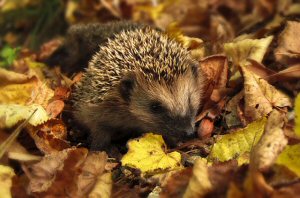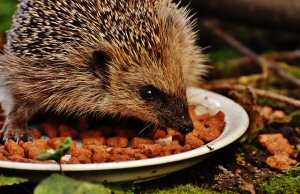Walks | Environment | Schools | Local notes | Links | Supporters | Wednesday Volunteers
Events | News | Newsletter | Contacts | Members | Archive | EASI | Laurel Park Orchard
|
Mammals |
Towards solving some prickly problems with hedgehog conservationA talk to the Berkshire Mammal Group and EEG by Dr Phil Baker,
|
| Mammals on Roads | One a year, reporters drive their usual routes. | 3% decline since 2002 |
| Living with Mammals | Garden survey by PTES. | 2% decline since 2004 |
| Garden Birdwatch | Mammals are an optional inclusion. | 2% rise since 2007 |
Likewise the Breeding Bird Survey from 1996, for which volunteers walk a transect twice a year. However, these are very partial, reliant on the self-selecting involvement of volunteers and partial submission of records, with no randomisation of samples and no standardisation of effort.
Take the counting of squashed hedgehogs on roads. How does the number reflect population and vulnerability to traffic? Is it true that the more casualties, the bigger the total population must be in proportion; or conversely, that the population must have suffered a decline due to increasing attrition? This becomes more complicated when one realises that, according to a Dutch study, hedgehogs actively avoid roads. Such evidence is borne out by further work at Southampton by Rondini and Doncaster (2002). Also, the access to the evidence is transient as carcasses disappear quickly and so is difficult to verify or even quantify.
 To make matters worse, however imperfect the evidence, the conclusions of these various surveys are inconsistent and even contradictory. They simply don't tell us the same things or even present a coherent trend. While most indicate decline, one (urban) survey suggests increasing numbers. What we need, Phil argued, is a robust technique allied to randomness of application so as to avoid the effects of recorder bias. Equipment should be accurate, cheap and verifiable if it is to keep the public engaged and allow widespread effort.
To make matters worse, however imperfect the evidence, the conclusions of these various surveys are inconsistent and even contradictory. They simply don't tell us the same things or even present a coherent trend. While most indicate decline, one (urban) survey suggests increasing numbers. What we need, Phil argued, is a robust technique allied to randomness of application so as to avoid the effects of recorder bias. Equipment should be accurate, cheap and verifiable if it is to keep the public engaged and allow widespread effort.
As gauging absolute numbers appears to be impossible for the present, let's settle for presence/absence. For this the hedgehog tunnel has been developed, allowing the capture of footprints in ink. However, we must also be aware of false absence; if we have no evidence of presence, how do we know if hedgehogs are not there? We may simply have missed them. How much is apparent absence down to animal distribution and have much to inaccurate technique?
One technique (Williams et al) is to work on a site that is under the management of one person alone. Ten tunnels are set out and checked repeatedly over five days. Tunnel locations are sited appropriately, though it is accepted that the reliance on edges is an assumption. In the reference survey 261 volunteers took part in monitoring rural sites - one of the biggest citizen science projects - while 219 volunteered for urban sites (in Reading). In the latter there was a 32% success rate in 2013 and 40% in 2014.
The urban study in 2013 indicated a 60% chance each day that hedgehogs would be present over the week; and in 2014, 68%. It revealed a tendency for hedgehogs to return each day and suggested that, if a tunnel was in a garden, they'd find it. Indeed, there was a 78% consistency of use. Conversely, if you don't get inky paw prints, it is because the hedgehog isn't in the garden. When homeowners where asked if they thought they had hedgehogs, or to predict their presence, 35% got it wrong. Indeed lots of residents thought there were very few in the Reading area, whereas Lower Earley actually has a good population.
Phil expressed himself satisfied with the technique for garden monitoring; it is certainly better than householder perception.
Badger sett density has a negative impact on hedgehogs - whereas houses appear to have a positive effect! After you've accounted for badgers, there are few impacts of significance. Badgers affect hedgehogs like nothing else does. Just how bad for hedgehogs might they be?
Actually, this is a more widely studied field, with three studies as a result of the government-sponsored badger cull alone! Hedgehogs don't tolerate badgers, so after the cull their numbers increased. Objectively, the lesson is clear: "fewer badgers; more hedgehogs". Hedgehogs are more present in urban areas than rural, a pattern that reflects badger distribution. Hubert et al (2011) studied the indirect evidence of food supply and concluded that hedgehogs avoid badgers by moving into town, where, coincidentally, people will also feed them!
Why are badgers a problem for hedgehogs? Eagles apart, badgers are the most likely source of predation, though no studies have been carried out on the direct effect of predation on the overall hedgehog population. More importantly, they compete for the same foodstuffs. One badger can eat as much as seven hedgehogs can. However, it is not the case that total food supplies have dwindled, as there has been sufficient to support an increase in badger numbers.
Humans have altered the rural landscape and unintentionally made the problem of predation and competition worse. Historically they co-existed after all. Gardens, however, represent a refuge from both. The challenge is to find sites that allow co-existence. Trading badgers for hedgehogs would be a 'hot potato', as the reaction to Phil's earlier comments by some members of the audience made only too clear!
Planting more hedgerows would be one answer, but that would cost large sums and having to record multiple sites to get the supporting information. Then farmers would have to be funded in order to make change viable. It would undoubtedly be expensive.
 Over-wintering behaviour has been studied in Sweden, where 25% to 40% of hedgehogs die each year. In the UK, survival rates are better:
18%-21%. The University of Reading has studied hibernation at locations near student accommodation in Gloucestershire
and Nottingham, using radio tagging. The research has revealed multiple nests, nest movement, moving around a lot before hibernation - but also two or three moves during the period of deep sleep. In one of the studies, 22 animals used an average of 6.5 nests. Good nest sites are required for security, cover, warmth and the abundance of nesting materials. Hedgehogs like to have options, to be able to move if needed. Good
quality hedgerows, woodland and brambles offer the best bets. If they get too cold (-5oC to -10oC)
they will have to wake up, so climate change is a potential problem as well. Perhaps the urban heat island effect is another reason for the perceived increase in preference for urban locations?
Over-wintering behaviour has been studied in Sweden, where 25% to 40% of hedgehogs die each year. In the UK, survival rates are better:
18%-21%. The University of Reading has studied hibernation at locations near student accommodation in Gloucestershire
and Nottingham, using radio tagging. The research has revealed multiple nests, nest movement, moving around a lot before hibernation - but also two or three moves during the period of deep sleep. In one of the studies, 22 animals used an average of 6.5 nests. Good nest sites are required for security, cover, warmth and the abundance of nesting materials. Hedgehogs like to have options, to be able to move if needed. Good
quality hedgerows, woodland and brambles offer the best bets. If they get too cold (-5oC to -10oC)
they will have to wake up, so climate change is a potential problem as well. Perhaps the urban heat island effect is another reason for the perceived increase in preference for urban locations?
Hedghogs need help with roads as the width of pavement and the speed and volume of traffic represent considerable challenges. Williams studied the effect of motorways for his PhD and tentatively came to the conclusion that they separated distinct populations that had little or no contact with each other. Populations are already patchy, with more places where hedgehogs are absent now than in the 1990s. And things are getting worse, as the Highways Agency installs solid concrete barriers rather than the old metal ones. The only viable crossings are bridges and underpasses - or purpose-built badger tunnels which come with an inherent danger! But even urban roads are a challenge.
Suffering poor, fragmented habitat and threatened by badgers, no wonder hedgehogs are heading for the towns! The only 'good news' for hedgehogs is the badger cull. (Interestingly the hedgehog hotspots are East Anglia, with a tradition of gamekeeper control of badgers and Yorkshire, with a tradition of badger-baiting.) More hedgerows are vital, but expensive. In the short term we can at least help the urban hedgehog.
It has been suggested that foxes pose a problem and indeed when the foxes of Bristol were suffering from mange a few years ago, hedgehogs appeared more numerous. However, although there have been a hundred studies of foxes' diet, hedgehogs feature very infrequently. And dogs tend to be indoors at the times hedgehogs are out and about.
We can provide sources of food (but should not offer cow's milk or mealworms), shelter and access. All sorts of threats can be moderated: litter, fences, rat boxes, bonfires, rubber bands. Decking is not good for food supply, though it is a good source of shelter. Phil noted that gardening and maintenance practice does make a difference. Ten years ago, you'd find plenty in the Harris Garden between 9-12pm, but not since the refuges have been systematically mown. As for holes in fences, 48,000 people have signed up to Hedgehog Street. According to the Earley gardens project (Piper 2016), we locally could do better!
If we double the access, we double the number of hedgehogs. There is no obvious difference in the gardens used. On any one night, a hedgehog might use eight gardens; a female might cover an area of 100m x 100x, or more if mating. So why not use all the gardens available? Is fear a deterent? We need to radio-track to see whether they use different gardens on different nights. Hog boxes - of which there are dozen of designs - are more likely to make a garden attractive, especially if placed nearer the house! It might take time, for although hedgehogs make repeat visits, their pattern of travel will change from year to year.
Summarised by Edwin A.R. Trout
DISCUSSION
Phil had promised to be provocative and play the devil's advocate, and certainly prompted reactions from the floor on a number of occasions during his talk. Where possible, the subject matter of interjected questions has been incorporated into the foregoing account, but there were several others on additional topics, as answered below.
Over the past 10-15 years there has been an upswing in the study of hedgehogs. However, there have been only two studies of diet since the 1970s. There have been no studies of the impact of deer on the density of woodland vegetation, though the question prompted an interested response.
The rehabilitation of injured hedgehogs provides a valuable function, except where the release occurs in an area remote from the hedgehogs' home territory.
'Tip-ex surveys' are a useful way of monitoring the number of individuals in a local population, thought this has raised concerns about the possible need for training and licensing in wildlife handling.
Do hedgehog have fleas? No, not to any significant degree.